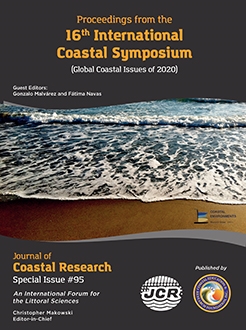Shim, K.T.; Kim, K.H.; Kim, H.D.; and Kwak, K.S., 2020. Analysis on sediment transport system in the East coast of Korea. In: Malvárez, G. and Navas, F. (eds.), Global Coastal Issues of 2020. Journal of Coastal Research, Special Issue No. 95, pp. 643–648. Coconut Creek (Florida), ISSN 0749-0208.
In an area comprising a long and a monotonous coastline such as that observed along the east coast of Korea, erosion and accretion can occur repeatedly due to seasonal influences; this leads to the formation of an equilibrium for the sediment budget. However, the construction of artificial structures has caused changes in the sediment budget, which has led to unidirectional sediment transport and excessive erosion and accretion. Recently, there has been an increase in the frequency of appearance of high wave groups that are observed for long periods due to a rise in the sea level and the emerging abnormal climate. This has caused large-scale morphological change and is the major factor that accelerates beach erosion. This study monitors a target area wherein a sediment transport was observed to actively occur; this was achieved by using a beach stabilization measure. The variations in the beach profile and the ratio of the sandy beach budget were predicted using the results obtained. In addition, the sediment transport system of the east coast of Korea was examined through comparison with empirical formulas by classifying the erosive and sedimentary beaches. This study also presents the indicators that will govern the topography of Korea in the future.





